Description
The painting uses the Holy Conversation composition, with the Madonna and Child in the center between two saints, a scheme widely used by Giovanni Bellini and other Venetian painters of the time.
It depicts, on a dark background, a thoughtful Madonna. The Child is rather fat, and is trying to reach St. Flavian of Ricina, painted on the left. The latter is offering Jesus a pierced heart, a symbol of the future Passion. The identification of Flavian, the patron of the city of Recanati in the Marche, is disputed, and some scholars identified him as Ignatius of Antioch: according to the legend, after his death his heart opened and the name of Jesus (as referred by Lotto with the monogram YHS on it) in golden letters.
On the right is Onuphrius the hermit, whose character was inspired by Dürer's Christ among the Doctors (Madrid, Museo Thyssen-Bornemisza), which the German artist had painted in Venice in 1506. Other elements recalling Dürer's works include the general asymmetry of the composition, the bright colors and the drapes, which Lotto had previous painted as screwed up paper, and are now instead softer and more colored.
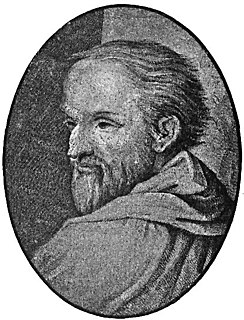
Antonio Allegri da Correggio, usually known as just Correggio, was the foremost painter of the Parma school of the High Italian Renaissance, who was responsible for some of the most vigorous and sensuous works of the sixteenth century. In his use of dynamic composition, illusionistic perspective and dramatic foreshortening, Correggio prefigured the Baroque art of the seventeenth century and the Rococo art of the eighteenth century. He is considered a master of chiaroscuro.

In art, a Madonna is a representation of Mary, either alone or with her child Jesus. These images are central icons for both the Catholic and Orthodox churches. The word is from Italian ma donna 'my lady' (archaic). The Madonna and Child type is very prevalent in Christian iconography, divided into many traditional subtypes especially in Eastern Orthodox iconography, often known after the location of a notable icon of the type, such as the Theotokos of Vladimir, Agiosoritissa, Blachernitissa, etc., or descriptive of the depicted posture, as in Hodegetria, Eleusa, etc.
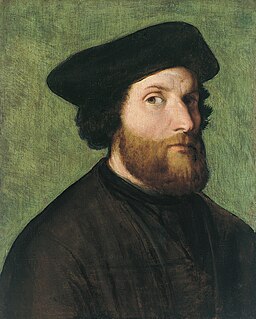
Lorenzo Lotto was an Italian painter, draughtsman, and illustrator, traditionally placed in the Venetian school, though much of his career was spent in other north Italian cities. He painted mainly altarpieces, religious subjects and portraits. He was active during the High Renaissance and the first half of the Mannerist period, but his work maintained a generally similar High Renaissance style throughout his career, although his nervous and eccentric posings and distortions represented a transitional stage to the Florentine and Roman Mannerists.

The Galleria Borghese is an art gallery in Rome, Italy, housed in the former Villa Borghese Pinciana. At the outset, the gallery building was integrated with its gardens, but nowadays the Villa Borghese gardens are considered a separate tourist attraction. The Galleria Borghese houses a substantial part of the Borghese Collection of paintings, sculpture and antiquities, begun by Cardinal Scipione Borghese, the nephew of Pope Paul V. The building was constructed by the architect Flaminio Ponzio, developing sketches by Scipione Borghese himself, who used it as a villa suburbana, a country villa at the edge of Rome.

Pinturicchio, or Pintoricchio, also known as Benetto di Biagio or Sordicchio, was an Italian painter during the Renaissance. He acquired his nickname because of his small stature and he used it to sign some of his artworks that were created during the fifteenth and sixteenth centuries.

Giovanni Battista Salvi da Sassoferrato, also known as Giovanni Battista Salvi, was an Italian Baroque painter, known for his archaizing commitment to Raphael's style. He is often referred to only by the town of his birthplace (Sassoferrato), as was customary in his time, and for example seen with da Vinci and Caravaggio.
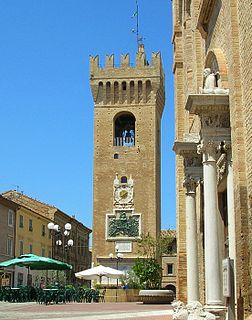
Recanati is a town and comune in the Province of Macerata, in the Marche region of Italy. Recanati was founded around 1150 AD from three pre-existing castles. In 1290 it proclaimed itself an independent republic and, in the 15th century, was famous for its international fair. In March 1798 it was conquered by Napoleon Bonaparte.

The Holy Family consists of the Child Jesus, the Virgin Mary and Saint Joseph. The subject became popular in art from the 1490s on, but veneration of the Holy Family was formally begun in the 17th century by Saint François de Laval, the first bishop of New France, who founded a confraternity.

The Madonna and Child with St. Anne is one of the mature religious works of the Italian Baroque master Caravaggio, painted in 1605–1606, for the altar of the Archconfraternity of the Papal Grooms in the Basilica of Saint Peter. The painting was briefly exhibited in the parish church for the Vatican, Sant'Anna dei Palafrenieri, before its removal, presumably due to its unorthodox portrayal of the Virgin. It was subsequently sold to Cardinal Scipione Borghese, and now hangs in his palazzo, where it shares space along with five other Caravaggios: Boy with a Basket of Fruit, David with the head of Goliath, Young Sick Bacchus, Saint Jerome Writing, and St John the Baptist in the Desert.

The Garvagh Madonna is an oil painting by the Italian Renaissance artist Raphael, dating to c. 1509–1510. It depicts the Virgin, the Christ Child and the infant John the Baptist, and is one of many paintings by Raphael with this trio. It is from early in the artist's third, or Roman period, in which distinctive changes are seen from his Umbrian or Florentine period in style and use of colour, with the introduction of more natural subjects and settings.
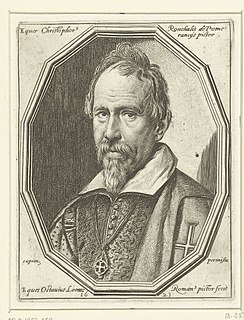
Cristoforo Roncalli was an Italian mannerist painter. He was one of the three painters known as Pomarancio or Il Pomarancio.
Events from the year 1508 in art.

Christ taking leave of his Mother is a subject in Christian art, most commonly found in Northern art of the 15th and 16th centuries. Christ says farewell to his mother Mary, often blessing her, before leaving for his final journey to Jerusalem, which he knows will lead to his Passion and death; indeed this scene marks the beginning of his Passion. In early versions just these two figures are usually shown, at half-length or less.

Christ among the Doctors is an oil painting by Albrecht Dürer, dating to 1506, now in the Museo Thyssen-Bornemisza, Madrid, Spain. The work dates to Dürer's sojourn in Venice, and was executed hastily while he was working at the Feast of the Rosary altarpiece.
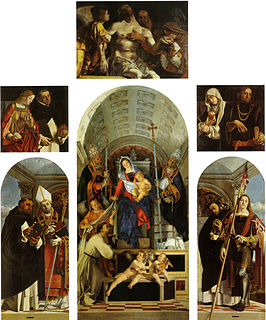
The Recanati Polyptych is a painting by the Italian Renaissance painter Lorenzo Lotto, executed in 1506-1508 and housed in the Civic Museum of Villa Colloredo Mels, Recanati, Italy. The work is dated and signed Laurent[ius] Lotus MDVIII.
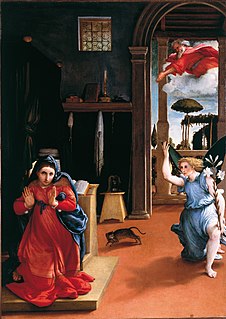
The Recanati Annunciation is a painting by the Italian Renaissance painter Lorenzo Lotto, executed around 1534 and housed in the Civic Museum of Villa Colloredo Mels, Recanati, Italy.

Santa Cristina al Tiverone Altarpiece is a painting by the Italian Renaissance painter Lorenzo Lotto, executed around 1504–1506. It is still housed in its original location, the parish church of Santa Cristina in Quinto di Treviso, a frazione of Treviso, northern Italy.
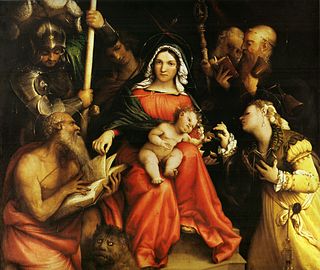
Mystical Marriage of St Catherine and Saints is an oil painting by Lorenzo Lotto, signed and dated of 1524, now in the Collections of the Galleria Nazionale d'Arte Antica, Rome, Italy.
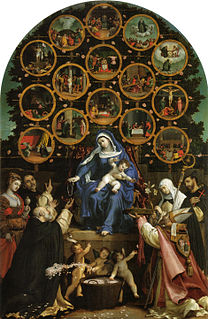
Madonna of the Rosary is a 1539 oil on canvas painting by Lorenzo Lotto, signed and dated below the Virgin Mary's feet ".L.LOTUS.MDXXXIX.".

Transfiguration is a signed 1510-1512 oil on panel painting of the Gospel episode the Transfiguration of Jesus by Lorenzo Lotto, produced for the church of Santa Maria di Castelnuovo and now in the Museo civico Villa Colloredo Mels in Recanati. It may originally have had a predella, part of which is Christ Leading the Apostles to Mount Tabor.



















